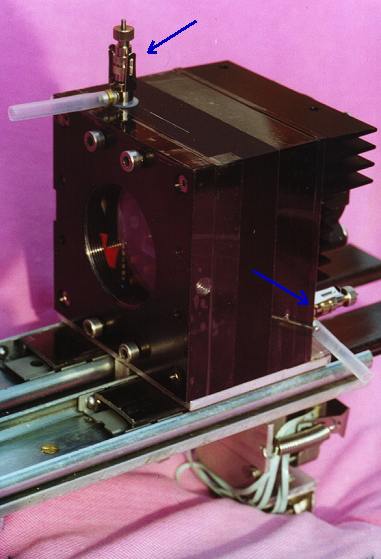
On our first tests with
Audine, we saw that the Kaf-400 sensor used to freeze when cooling the camera.
So we took an inventory of all the solutions that could be used to avoid freezing:
- Create a vacuum; the most efficient mean for eliminating freezing!...but one
of the most complex: it needs to modify the original housing of the camera,
to buy a vacuum pump, etc...
- Dry the air inside the camera with silica gel for example; It seems not to
be really efficient according to some 'specialists'; the disadvantages are a
risk to introduce silica gel dust, the need to often open the camera to regenerate
the silica gel,... But it's one of the most simple and cheap solution.
- Filling the camera with dry and neutral gas, at the atmospheric pressure.
It's possible to buy very dry gas (99,...% of humidity); It can be nitrogen,
or an other non-flammable dry gaz... However, buying nitrogen gaz cylinder and
pressure reducer is often very expensive and not really profitable (a little
less if you belong to an astronomy club).

So we decided to try
to fill the camera with a dry gas in an aerosol can (usually used for cleaning
photographic optics, lenses,... and cheap (about 50 Francs or 8 $US).
We had to fix two valves on the housing of the camera: we've used two little
valves usually used in gasoline supply for model airplanes. We drilled a 4mm
hole in the side and the back of the camera ans screwed the valves, with a rubber
seal (in order to improve airtightness). We also applied silicone around the
plugs. The valves cost me about 70-80Fr (10-12$). Recently, Claude Gragnolati
such valves for 58Fr; He gave me its reference: "plateau gicleur pour OS 30,
3V FP, needle Valve assembly 22281903".

The filling of the camera
is made with a plastic tube...Once the camera is sufficiently filled, close
the valves and try to cool; fill it once again if it the CCD freezes...
It's not really easy to determine when the camera is filled...you'll have to
test it; Nevertheless, I saw that the gaz is heavier than the air, so you'd
better fill the camera with the admission valve under the exit valve (which
is the contrary of the photo below!)
According to our tests, the camera is keeping dry during about one week (but
it may certainly depend of the ambiant atmosphere...)
Thanks to this device, we can cool at -20°C (-4°F or 253°K) without
any problems of freezing, and the temperature can certainly be lower... (recently
we colled at -30°C).

An other view of the camera with the two valves
Others solutions?... :
How to do if you don't find of don't want to use this kind of neutral gas?... A good passive protection against frost seems to use pieces of foam to fill the camera... or at least to lower the volume of air inside. Jean Montanné uses this solution with much success (see Audine Connexion page).
![]()
Contact: ![]() (pas de lien direct: protection anti-spam)
(pas de lien direct: protection anti-spam)